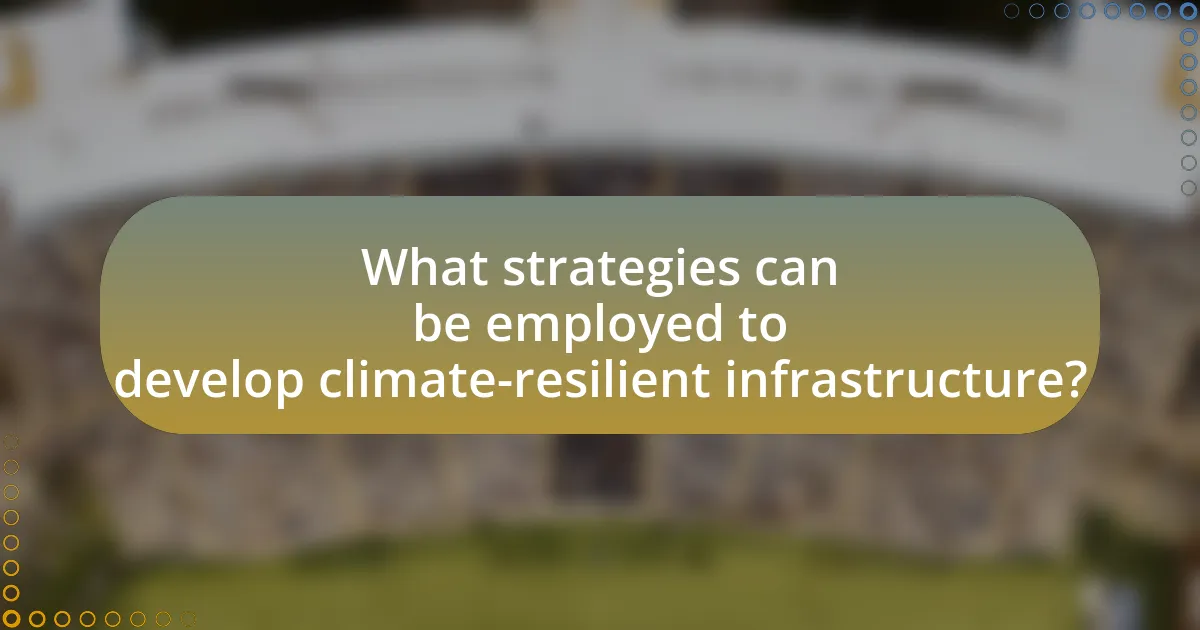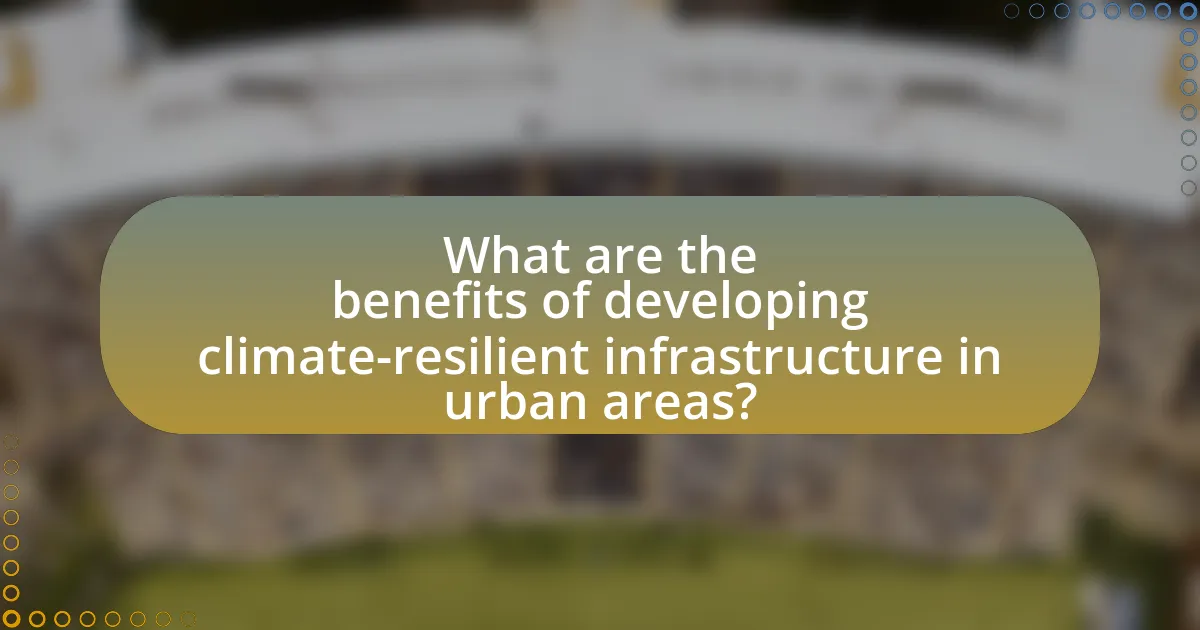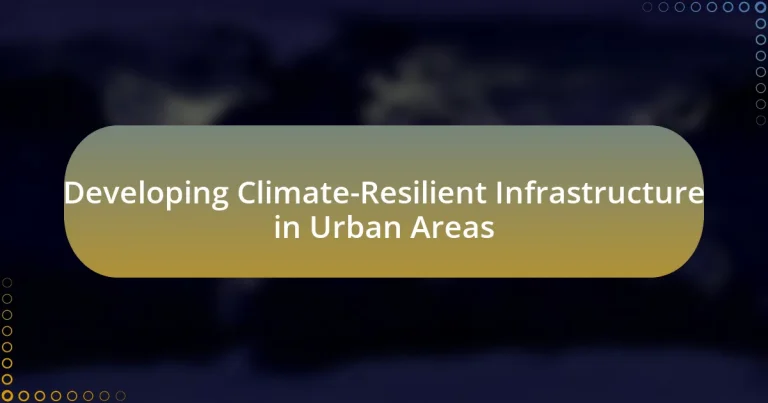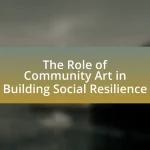Climate-resilient infrastructure in urban areas is essential for adapting to the impacts of climate change, including extreme weather events and rising sea levels. This article outlines the characteristics and importance of such infrastructure, highlighting strategies for development, including the integration of green infrastructure and adaptive design principles. It also addresses the challenges urban areas face, the economic implications of inadequate resilience, and the role of technology and stakeholder engagement in enhancing infrastructure resilience. Case studies from cities like New York and Rotterdam exemplify successful approaches to building climate-resilient systems, providing valuable lessons for future urban planning initiatives.

What is Climate-Resilient Infrastructure in Urban Areas?
Climate-resilient infrastructure in urban areas refers to the design and construction of facilities and systems that can withstand and adapt to the impacts of climate change, such as extreme weather events, rising sea levels, and temperature fluctuations. This type of infrastructure incorporates sustainable practices, such as using durable materials, implementing green spaces, and enhancing drainage systems to mitigate flooding. For example, cities like New York have invested in green roofs and permeable pavements to manage stormwater effectively, demonstrating the practical application of climate-resilient strategies.
How does climate resilience apply to urban infrastructure?
Climate resilience applies to urban infrastructure by ensuring that systems are designed and built to withstand and adapt to the impacts of climate change, such as extreme weather events, flooding, and rising temperatures. This involves integrating sustainable practices, such as green roofs, permeable pavements, and enhanced drainage systems, which can reduce vulnerability and improve recovery times. For instance, cities like New York have invested in resilient infrastructure projects, including the East Side Coastal Resiliency Project, which aims to protect neighborhoods from storm surges and flooding, demonstrating the effectiveness of proactive measures in urban planning.
What are the key characteristics of climate-resilient infrastructure?
Climate-resilient infrastructure is characterized by its ability to withstand and adapt to the impacts of climate change. Key characteristics include durability, which ensures structures can endure extreme weather events; flexibility, allowing for modifications in response to changing conditions; and sustainability, incorporating eco-friendly materials and practices. Additionally, climate-resilient infrastructure often features redundancy, providing alternative systems to maintain functionality during disruptions, and integration with natural systems, enhancing ecosystem services. These characteristics are essential for minimizing damage and ensuring long-term viability in urban environments facing climate challenges.
Why is climate resilience important for urban areas?
Climate resilience is crucial for urban areas because it enables cities to withstand and recover from climate-related disruptions, such as extreme weather events and rising sea levels. Urban areas, which house over half of the global population, are particularly vulnerable to these impacts due to their dense infrastructure and economic activities. For instance, the National Oceanic and Atmospheric Administration (NOAA) reports that climate change could lead to increased flooding, which threatens urban infrastructure and public safety. By investing in climate resilience, cities can protect their economies, ensure public health, and maintain essential services, ultimately fostering sustainable development and enhancing the quality of life for residents.
What challenges do urban areas face regarding climate resilience?
Urban areas face significant challenges regarding climate resilience, including infrastructure vulnerability, socio-economic disparities, and inadequate planning. Infrastructure in cities often lacks the robustness to withstand extreme weather events, such as flooding and heatwaves, which are becoming more frequent due to climate change. For instance, the National Oceanic and Atmospheric Administration reported that urban flooding has increased by 50% in the last decade, highlighting the urgent need for resilient infrastructure. Socio-economic disparities exacerbate these challenges, as marginalized communities often lack resources to adapt or recover from climate impacts, leading to unequal vulnerability. Additionally, many urban planning frameworks do not adequately incorporate climate risk assessments, resulting in insufficient preparedness for future climate scenarios. These factors collectively hinder the ability of urban areas to effectively respond to and recover from climate-related disruptions.
How do extreme weather events impact urban infrastructure?
Extreme weather events significantly damage urban infrastructure by causing physical destruction, disrupting services, and increasing maintenance costs. For instance, hurricanes can lead to flooding that damages roads, bridges, and public transportation systems, as seen during Hurricane Sandy in 2012, which caused an estimated $19 billion in infrastructure damage in New York City alone. Additionally, extreme heat can weaken materials, leading to road buckling and increased energy demand for cooling, which strains electrical grids. The increasing frequency and intensity of such events necessitate the development of climate-resilient infrastructure to mitigate these impacts and ensure urban areas can withstand future challenges.
What are the economic implications of failing to develop climate-resilient infrastructure?
Failing to develop climate-resilient infrastructure leads to significant economic losses, including increased repair costs, reduced productivity, and heightened vulnerability to climate-related disasters. For instance, the National Oceanic and Atmospheric Administration reported that the U.S. experienced over $1 trillion in damages from climate-related events between 1980 and 2020, highlighting the financial burden of inadequate infrastructure. Additionally, the World Bank estimates that climate change could push 100 million people into extreme poverty by 2030, primarily due to the economic disruptions caused by failing infrastructure. These implications underscore the necessity for investment in resilient systems to mitigate future economic risks.

What strategies can be employed to develop climate-resilient infrastructure?
To develop climate-resilient infrastructure, strategies such as integrating green infrastructure, enhancing building codes, and employing adaptive design principles can be employed. Green infrastructure, like permeable pavements and green roofs, helps manage stormwater and reduce urban heat, thereby mitigating flooding and heat-related issues. Strengthening building codes ensures that structures can withstand extreme weather events, as evidenced by the adoption of the International Building Code, which incorporates resilience measures. Adaptive design principles allow infrastructure to be flexible and responsive to changing climate conditions, as seen in projects that incorporate modular designs and materials that can be easily replaced or upgraded. These strategies collectively enhance the durability and functionality of urban infrastructure in the face of climate change.
How can urban planning contribute to climate resilience?
Urban planning can significantly contribute to climate resilience by integrating sustainable practices that mitigate the impacts of climate change. Effective urban planning incorporates green infrastructure, such as parks and green roofs, which can reduce urban heat and manage stormwater, thereby decreasing flooding risks. For instance, cities like New York have implemented green infrastructure strategies that have led to a 30% reduction in stormwater runoff, demonstrating the effectiveness of these approaches. Additionally, urban planning can promote mixed-use developments and public transportation systems, which reduce reliance on cars, lower greenhouse gas emissions, and enhance community resilience. Evidence from cities that have adopted such planning measures shows improved adaptability to climate-related challenges, reinforcing the importance of strategic urban design in fostering climate resilience.
What role does green infrastructure play in enhancing resilience?
Green infrastructure plays a crucial role in enhancing resilience by mitigating the impacts of climate change and extreme weather events. It achieves this through natural systems such as parks, green roofs, and permeable pavements that manage stormwater, reduce urban heat, and improve air quality. For instance, a study by the National Oceanic and Atmospheric Administration found that urban green spaces can reduce surface temperatures by up to 5 degrees Fahrenheit, thereby lowering energy demands and enhancing community health. Additionally, green infrastructure can absorb and filter rainwater, reducing flooding risks and improving water quality, which is vital for urban areas facing increased precipitation due to climate change.
How can technology be leveraged to improve infrastructure resilience?
Technology can be leveraged to improve infrastructure resilience by utilizing advanced data analytics, real-time monitoring systems, and predictive modeling. These technologies enable cities to assess vulnerabilities, optimize resource allocation, and enhance response strategies during climate-related events. For instance, the integration of Internet of Things (IoT) sensors in critical infrastructure allows for continuous monitoring of structural health, providing early warnings for maintenance needs or potential failures. Additionally, geographic information systems (GIS) can analyze spatial data to identify high-risk areas and inform urban planning decisions. Research from the National Institute of Standards and Technology indicates that implementing smart technologies can reduce infrastructure damage costs by up to 30% during extreme weather events, demonstrating the effectiveness of technology in enhancing resilience.
What are the best practices for implementing climate-resilient infrastructure?
The best practices for implementing climate-resilient infrastructure include conducting thorough risk assessments, integrating nature-based solutions, utilizing sustainable materials, and ensuring community engagement throughout the planning process. Risk assessments identify vulnerabilities to climate impacts, enabling targeted interventions; for instance, the National Oceanic and Atmospheric Administration emphasizes the importance of understanding local climate risks to inform infrastructure design. Nature-based solutions, such as green roofs and permeable pavements, enhance urban resilience by managing stormwater and reducing heat, as supported by research from the World Resources Institute. Sustainable materials, like recycled concrete and low-carbon steel, contribute to reducing the carbon footprint of infrastructure projects, aligning with findings from the Global Infrastructure Facility. Lastly, community engagement fosters local ownership and ensures that infrastructure meets the needs of residents, as highlighted by the American Planning Association’s guidelines on participatory planning.
How can stakeholder engagement enhance the development process?
Stakeholder engagement enhances the development process by fostering collaboration, ensuring diverse perspectives are considered, and increasing project acceptance. Engaging stakeholders, such as community members, government agencies, and private sector partners, allows for the identification of local needs and priorities, which leads to more effective and tailored solutions. Research indicates that projects with active stakeholder involvement are 30% more likely to succeed, as they address concerns early and build trust among participants. This collaborative approach not only improves the quality of the infrastructure but also promotes sustainability and resilience in urban areas facing climate challenges.
What funding mechanisms are available for climate-resilient projects?
Funding mechanisms available for climate-resilient projects include government grants, private investments, public-private partnerships, and international financial institutions. Government grants often come from federal or state programs aimed at enhancing resilience against climate impacts, such as the Federal Emergency Management Agency’s Hazard Mitigation Grant Program. Private investments can be sourced from venture capital focused on sustainable technologies. Public-private partnerships leverage resources from both sectors to fund infrastructure projects, while international financial institutions like the World Bank and the Green Climate Fund provide loans and grants specifically for climate adaptation initiatives. These mechanisms are essential for mobilizing the necessary capital to implement effective climate-resilient infrastructure in urban areas.

What are the benefits of developing climate-resilient infrastructure in urban areas?
Developing climate-resilient infrastructure in urban areas enhances community safety, economic stability, and environmental sustainability. This type of infrastructure is designed to withstand extreme weather events, reducing damage and recovery costs. For instance, cities that invest in flood-resistant drainage systems can significantly lower the risk of flooding, which, according to the National Oceanic and Atmospheric Administration, can save up to $6 for every $1 spent on mitigation. Additionally, climate-resilient infrastructure promotes long-term economic growth by attracting businesses and investments, as companies prefer locations that minimize operational disruptions. Furthermore, such infrastructure supports environmental health by incorporating green spaces and sustainable materials, which improve air quality and biodiversity.
How does climate-resilient infrastructure improve public safety?
Climate-resilient infrastructure improves public safety by reducing vulnerability to climate-related hazards such as floods, storms, and heatwaves. This type of infrastructure is designed to withstand extreme weather events, thereby minimizing damage to critical facilities like hospitals, emergency services, and transportation networks. For instance, elevated roadways and flood barriers can prevent water damage during heavy rainfall, ensuring that emergency responders can operate effectively. Additionally, climate-resilient designs often incorporate green spaces and permeable surfaces, which can mitigate urban heat and improve air quality, further enhancing community health and safety. Studies have shown that cities investing in climate-resilient infrastructure experience fewer disruptions during extreme weather events, leading to lower injury rates and improved overall public safety.
What are the long-term economic benefits of investing in resilience?
Investing in resilience yields long-term economic benefits by reducing future disaster recovery costs and enhancing community stability. For instance, every dollar spent on disaster preparedness can save up to $6 in recovery costs, as demonstrated by the National Institute of Building Sciences. Additionally, resilient infrastructure attracts investment, boosts property values, and creates jobs, contributing to sustained economic growth. Studies indicate that cities with resilient infrastructure experience lower insurance premiums and reduced economic disruptions, further solidifying the financial advantages of such investments.
How does climate resilience contribute to community well-being?
Climate resilience enhances community well-being by reducing vulnerability to climate-related hazards, thereby ensuring safety and stability. Communities that invest in climate-resilient infrastructure, such as flood defenses and heat-resistant buildings, experience fewer disruptions during extreme weather events, which leads to improved public health and economic stability. For instance, a study by the National Oceanic and Atmospheric Administration (NOAA) found that communities with robust climate adaptation strategies can save up to $1.5 billion annually in disaster recovery costs. This financial security fosters a sense of safety and encourages social cohesion, ultimately contributing to a higher quality of life for residents.
What lessons can be learned from successful climate-resilient infrastructure projects?
Successful climate-resilient infrastructure projects demonstrate the importance of integrating adaptive design, stakeholder engagement, and sustainable materials. Adaptive design allows infrastructure to withstand extreme weather events, as seen in the Netherlands’ flood defense systems, which incorporate flexible barriers that adjust to changing water levels. Stakeholder engagement ensures that community needs and local knowledge inform project planning, exemplified by the participatory approach used in New York City’s post-Sandy recovery efforts, which led to more effective and accepted solutions. Additionally, the use of sustainable materials reduces environmental impact and enhances durability, as evidenced by the incorporation of recycled materials in the construction of resilient roads in California. These lessons highlight the necessity of a holistic approach to infrastructure development that prioritizes resilience, community involvement, and sustainability.
What case studies exemplify effective climate resilience in urban areas?
Case studies that exemplify effective climate resilience in urban areas include New York City’s post-Hurricane Sandy initiatives, which involved the construction of storm surge barriers and the enhancement of green infrastructure, such as parks and green roofs, to manage flooding. Another notable example is Rotterdam, which has implemented a comprehensive water management strategy that includes floating buildings and water plazas to adapt to rising sea levels. Additionally, the city of Copenhagen has developed a cloudburst management plan that integrates urban design with stormwater management to mitigate flooding during heavy rainfall events. These case studies demonstrate successful integration of infrastructure and urban planning to enhance resilience against climate impacts.
How can these lessons be applied to future projects?
Lessons from developing climate-resilient infrastructure can be applied to future projects by integrating adaptive design principles and stakeholder engagement strategies. For instance, incorporating flexible infrastructure that can withstand extreme weather events ensures longevity and reduces maintenance costs. A study by the National Institute of Building Sciences found that every dollar invested in disaster mitigation saves an average of six dollars in future disaster costs, highlighting the economic benefits of such approaches. Additionally, involving local communities in the planning process fosters a sense of ownership and ensures that the infrastructure meets the specific needs of the population, as evidenced by successful projects in cities like New Orleans and Rotterdam.
What practical steps can urban planners take to enhance climate resilience?
Urban planners can enhance climate resilience by implementing green infrastructure, such as green roofs, permeable pavements, and urban forests, which help manage stormwater and reduce urban heat. These strategies mitigate flooding and lower temperatures in urban areas, contributing to overall climate adaptation. For instance, cities like Philadelphia have successfully integrated green stormwater infrastructure, resulting in a 30% reduction in combined sewer overflows, demonstrating the effectiveness of such measures. Additionally, urban planners should prioritize mixed-use developments and transit-oriented designs to reduce reliance on automobiles, thereby decreasing greenhouse gas emissions and promoting sustainable living.

